UKCAT Conditional Abstract Test Patterns
UKCAT abstract reasoning test evaluates your ability to see relationships between information provided. In other words, it tests your ability to extract and judge relevant pieces of information from large set of data. Some candidates may think that abstract reasoning tests are difficult and hard to prepare for. This may not be necessarily true if you choose right practice materials and practice well in advance of your assessment. In this section we will review questions that are based on conditional patterns which in essence are patterns where characteristic of one item dictates the characteristic of another. If you wish to see related tutorials then refer to section on common abstract reasoning test patterns.
As mentioned above In UKCAT abstract reasoning tests conditional patterns are patterns where characteristic of particular item is dictated by another item. A good example of conditional patterns is demonstrated below. Consider set A and set B and try to find the relationship between the items in set A and B and then evaluate whether test shapes belong to set A, B or neither set.
 |
Determine whether the test shapes belong to set A, set B or neither.
If you found the above pattern difficult don't be discouraged. You will improve with necessary commitment and practice. When you examine the set A you may be mystified at first however when you take a hard look you can see that each box that contains even number has black circle in it whereas the box with odd number contains white circle. When you examine set B where the opposite is true, that is, if the box contains even number it has white circle in it whereas if there is black circle it has odd number. Hence, based on these conditionals you may conclude that test shape 1 must belong to set A as it has odd number with white circle whereas test shape 2 must belong to set B as the opposite is true. For test shape 3 you may conclude that it belongs to neither set as it has two small circles in it.
Now take one minute to find the conditional pattern in the below set extracted from UKCAT abstract reasoning test. You can make notes on scrap paper and then take no more than 30 seconds to evaluate test shapes.
 |
Determine whether the test shapes belong to set A, set B or neither.
How did it go? Did you find the pattern? If not don’t panic with more practice you will train yourself to master these types of questions. Note that the most obvious part of the pattern is that in each box there is an arrow pointing either to the left or right. Hence, now you are half way through to solving conditional which entails that if arrow in boxes of set A points to the left the larger shape is black whereas the smaller shape is white and when the arrow points to the right smaller shape is black whereas the larger shape is white. Note that the position of arrows within the box does not dictate any rule. The opposite applies for set B and hence you can conclude that test shape 1 belongs to set B whereas test shape 2 to set A and shape 3 belongs to neither set as it does not follow the conditionals of any of the sets.
Generally speaking, questions with conditional patterns may be time consuming and difficult to figure out and at times difficult to evaluate as you have to apply conditionals from Set A and Set B to arrive at the correct answer. However, with systematic practice you can improve your test taking strategies and approach the test with confident mindset to succeed. You can see abstract reasoning practice tips which will give you some advice on how to go about practicing and answering these types of questions.

